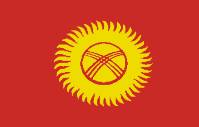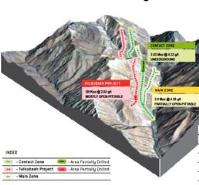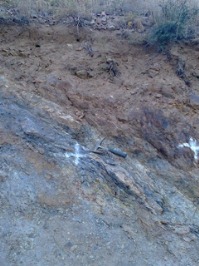Special Program for International Students
GRADUATE COURSE IN EARTH SCIENCE
& GEOENVIRONMENTAL SCIENCE
Current MEXT students



Almaz Cholponkulov (Kyrgyzstan)
Email: s129312 @matsu.shiamne-u.ac.jp
Thesis title: Hydrothermal alteration and link to gold mineralization in the Chaarat gold deposit in the Central Tien-Shan, Kyrgyzstan.
Supervisor: Assoc. Prof. Hiroto Ohira (2012-2014)
The object of my study is the gold-bearing Chaarat deposit, which is located within the Pskem and Sandalash Ranges of the Kyrgyz Tien Shan, in the Chatkal administrative district of the Jalal-Abad region, Kyrgyz Republic. The Chatkal Valley has proved to be of interest to many explorers, not only for its numerous placer deposits, but also due to the presence of a number of ore occurrences and deposits. The Chaarat deposit is one of these occurrences, but it has not yet been studied in detail.
The deposit formed in the last stage of Permian orogenesis which was completed by the intrusion of diorite masses. All known ore occurrences and deposits formed by hydrothermal alteration which is clearly associated with tectonic features such as faults and crush zones.
Hydrothermal alteration is widespread in my study area in the Chaarat gold-quartz-sulfide deposit. This includes potassic alteration, propylitization, greisenization, alkaline metasomatism, and silicification, as well as sericitic and argillic alteration. The types of changes were classified in accordance with the paragenesis of minerals recognized macroscopically in the field.
With falling temperatures and pressures, hydrothermal alteration usually shows progressive zoning, both spatially and temporally, with change from the alkaline alteration close to the heat source through to argillic alteration at distance. Heat is transferred either through direct contact with the intruded magma, or by the circulation of fluids heated by the magma. Fluids circulating in the pre-and syn-magmatic faults and fractures, as well as through interconnected pores, give rise to diffuse changes and variable levels of mineralization.
However, field observations do not reveal a simple zoning change, but identify complex overprinting of highly alkali or acid alteration at low temperatures. This is interpreted as the product of polycyclic changes caused by the polyphase intrusion of differing magmas (diorite, granodiorite, syenite), variable length (larger igneous bodies, small dikes, and sills), as well as the supply of heat. These processes produce changes at zonal scale, specific to the heat delivered and the volume of liquid from the convection cell. The changes are thus, cyclical and polyphasic, and mineral parageneses characteristic of each type of change are likely to form diachronously. In this study I intend to examine the hydrothermal alteration and relation to mineralization and intrusive bodies and their thermochronology of this alteration. Improved understanding of the hydrothermal alteration will help to find the reason for the presence of native gold occurrence in the Tulkubash Formation, and its absence in the Chaarat Formation.
Purpose: To study the hydrothermal alteration and thermochronology of the Chaarat gold deposit, for future extension for exploration areas in the Sandalash district.
Aims:
- To determine the alteration and vein mineralogy, using optical techniques.
- To examine mineral associations and parageneses, and to characterize the fluids responsible for metal transport.
- EPMA analysis of the ore minerals.
- Chemical analyses of the host rocks and intrusives.
- Fluid inclusiona analysis.
- Thermochronological studies.
